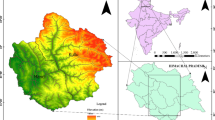Abstract
In this study, land use change and its effects on level and volume of groundwater were investigated. Using satellite images and field measurements, change in land uses was determined from 1998 to 2007. By analyzing the observation wells data and preparing the zoning maps in GIS, groundwater level fluctuations were assessed. Considering the area corresponding to these fluctuations, changes in aquifers volume were calculated. The rain gauge and synoptic stations data were used to calculate meteorological parameters and evapotranspiration. The water requirement of the main crops was determined by CROPWAT software. Results showed an increase in average rainfall and crops water requirement. The classification of satellite images showed that 11,800 ha was increased in lands under irrigated crops cultivation, while 27,655 ha of rangeland was declined in the region. Groundwater levels dropped an average of 7 m, equal to 63.4 MCM reductions in volume of water in the aquifer.






Similar content being viewed by others
Notes
Integrated Land and Water Information System
Normalized Differences Vegetation Index
References
Amini, A., & Homayounfar, V. (2016). The groundwater balance in alluvial plain aquifer at Dehgolan, Kurdistan, Iran. Applied Water Science. doi:10.1007/s13201-016-0445-9.
Amini, A., Ali, T. M., Ghazali, H., & Huat, B. (2009). Adjustment of peak streamflows of a tropical river for urbanization. American Journal of Environmental Sciences, 5(3), 285–294.
Amini, A., Ali, T. M., Ghazali, H., Huat, B., Aziz, A., & Akib, S. (2011). Impacts of land use change on streamflow generation in Damansara watershed, Malaysia. Arabian Journal for Science and Engineering, 36, 713–720.
Amini, A., Zareie, S., Taheri, P., Wan, K. B. Y., & Mustafa, M. R. (2016). In D. Bucur (Ed.), Drought analysis and water resources management inspection in Euphrates-Tigris Basin, River Basin management. Romania: InTech Publication.
Arabatzis, G., & Polyzos, S. (2007). The impacts of the CAP reform on land uses and the forest development. European Spatial Research and Policy, 14(2), 89–106.
FAO (Food and Agriculture Organization) (1992). A computer program for irrigation planning and management; FAO Irrigation and Drainage Paper No.46, Rome, Italy.
Farshi, A., Shariati, M. R., Jarollahi, R., Ghaemi, M. R., Shahabifar, M., & Tavallaei, M. M. (1997). An estimate of the water requirements of main field crops and orchards in Iran, orchards. Karaj: Agricultural Education Publication 629P.
Farsi, G., & Yusefi, M. (2013). Land use changes detection using remote sensing data (case study: Bojnord Plain). Journal Geography and Environmental Studies, 7(2), 95–106.
Hesami, A., & Amini, A. (2016). Changes in irrigated land and agricultural water use in the Lake Urmia Basin. Lake and Reservoir Management, 32, 288–296.
Kurdistan Regional Water Authority, KRWA (2010). Report justification to extend the ban on the eastern plains of Kurdistan. Water-based office of the Kurdistan Regional Water Authority.
Lawniczak, A. E., Zbierska, J., Nowak, B., et al. (2016). Impact of agriculture and land use on nitrate contamination in groundwater and running waters in central-west Poland. Environmental Monitoring and Assessment, 188, 172. doi:10.1007/s10661-016-5167-9.
Lee, J. Y., Yi, M. J., Moon, S. H., Cho, M., Won, J. H., Ahn, K. H., & Lee, J. M. (2007). Causes of the changes in groundwater level at Daegu, Korea: the effect of subway excavations. Bulletin of Engineering Geology and the Environment, 66, 251–258.
Li, J., Tan, S., Chen, F., & Feng, P. (2014). Quantitatively analyze the impact of land use/land cover change on annual runoff decrease. Natural Hazards, 74(2), 1191–1207.
Lo, C. P., & Quattrochi, D. (2003). A land-use and land-cover change, urban heat island phenomenon, and health implications: a remote sensing approach. Photogrammetric Engineering and Remote Sensing, 69(9), 1053–1063.
Matsushita, B., Wei, Y., Jin, C., Yuyichi, O., & Guoyn, Q. (2007). Sensitivity of the Enhanced Vegetation Index (EVI) and Normalized Difference Vegetation Index (NDVI) to topographic effects: a case study in high-density Cypress forest. Sensors. www.mdpi.org/sensors. Accessed 2015.
Palamuleni, L. G., Ndomba, P. M., & Annegarn, H. J. (2011). Evaluating land cover change and its impact on hydrological regime in Upper Shire river catchment, Malawi. Journal of Regional Environmental Change, 11(4), 845–855.
Pikounis, M., Varanou, E., Baltas, E., Dassaklis, A., & Mimikou, M. (2003). Application of the SWAT model in the Pinos river watershed under different scenarios. International Conference on Environmental Science and Technology., 5(2), 71–79.
Pisinaras, V., Petalas, C., Tsihrintzis, V. A., & Zagana, E. (2007). A groundwater flow model for water resources management in the Ismarida plain, North Greece. Environmental Modeling and Assessment Journal, 12(75Y89), 75–89.
Prasad, R. K., Singh, V. S., Krishnamacharyulu, S. K. G., et al. (2011). Application of drastic model and GIS: for assessing vulnerability in hard rock granitic aquifer. Environmental Monitoring and Assessment, 176, 143. doi:10.1007/s10661-010-1572-7.
Rangzan, K., Khorshidi, S., & Abshirini. (2009). Combining NDVI index and thermal band satellite images to extract the vegetation density map using RS and GIS (case study: Kamanestan basin). Tehran: Geomatics Conferences: Survey Organization.
Salmani, H., Rouhani, H., Mohseni Saravi, M., & Salajagheh, E. (2012). Assessment of change and its impact on the hydrological regime of the basin Qazzaqli Golestan. Journal of Watershed Management Research, 3(6), 1–18.
Sofios, S., Arabatzis, G., & Baltas, V. (2008). Policy for management of water resources in Greece. The Environmentalist, 28(3), 185–194.
Versace, V. L., Ierodiaconou, D., Stagnitti, F., et al. (2008). Regional-scale models for relating land cover to basin surface-water quality using remotely sensed data in a GIS. Environmental Monitoring and Assessment, 142, 171. doi:10.1007/s10661-007-9918-5.
Zhang, W., Yan, Y., Zheng, J., Li, L., Dong, X., & Cai, H. (2009). Temporal and spatial variability of annual extreme water level in the Pearl River Delta region, China. Journal of the Global and Planetary Change, 69, 35–47.
Acknowledgments
This research was implemented with the financial support of the KRWA. Hereby, the carried out collaboration and support are acknowledged.
Author information
Authors and Affiliations
Corresponding author
Rights and permissions
About this article
Cite this article
Amini, A., Hesami, A. The role of land use change on the sustainability of groundwater resources in the eastern plains of Kurdistan, Iran. Environ Monit Assess 189, 297 (2017). https://doi.org/10.1007/s10661-017-6014-3
Received:
Accepted:
Published:
DOI: https://doi.org/10.1007/s10661-017-6014-3




